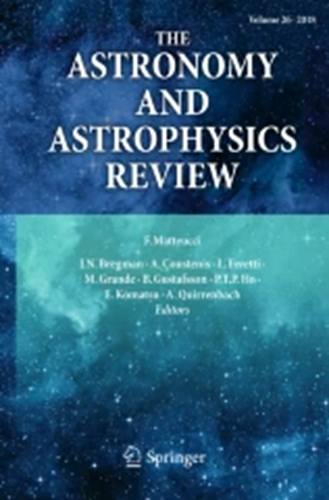Refining Saturn's deuterium-hydrogen ratio via IRTF/TEXES spectroscopy
IF 26.5
1区 物理与天体物理
Q1 ASTRONOMY & ASTROPHYSICS
引用次数: 1
Abstract
The abundance of deuterium in giant planet atmospheres provides constraints on the reservoirs of ices incorporated into these worlds during their formation and evolution. Motivated by discrepancies in the measured deuterium-hydrogen ratio (D/H) on Jupiter and Saturn, we present a new measurement of the D/H ratio in methane for Saturn from ground-based measurements. We analysed a spectral cube (covering 1151-1160 cm−1 from 6 February 2013) from the Texas Echelon Cross Echelle Spectrograph (TEXES) on NASA’s Infrared Telescope Facility (IRTF) where emission lines from both methane and deuterated methane are well resolved. Our estimate of the D/H ratio in stratospheric methane, 1.65+0.27 −0.21 × 10−5 is in agreement with results derived from Cassini CIRS and ISO/SWS observations, confirming the unexpectedly low CH3D abundance. Assuming a fractionation factor of 1.34 ± 0.19 we derive a hydrogen D/H of 1.23+0.27 −0.23 × 10−5. This value remains lower than previous tropospheric hydrogen D/H measurements of (i) Saturn 2.10(±0.13) × 10−5, (ii) Jupiter 2.6(±0.7) × 10−5 and (iii) the proto-solar hydrogen D/H of 2.1(±0.5) × 10−5, suggesting that the fractionation factor may not be appropriate for stratospheric methane, or that the D/H ratio in Saturn’s stratosphere is not representative of the bulk of the planet.通过IRTF/TEXES光谱精炼土星的氘氢比
巨行星大气中氘的丰度限制了这些行星在形成和演化过程中形成的冰库。由于木星和土星上测量的氘氢比(D/H)的差异,我们提出了一种新的基于地面测量的土星甲烷D/H比的测量方法。我们分析了来自美国宇航局红外望远镜设施(IRTF)上的德克萨斯梯队交叉梯队光谱仪(TEXES)的光谱立方体(覆盖1151-1160 cm−1,2013年2月6日),其中甲烷和氘化甲烷的发射线都得到了很好的解析。我们估计平流层甲烷的D/H比为1.65+0.27−0.21 × 10−5,与卡西尼号CIRS和ISO/SWS观测的结果一致,证实了意想不到的低CH3D丰度。假设分馏系数为1.34±0.19,我们得到氢的D/H为1.23+0.27−0.23 × 10−5。这个值仍然低于之前的对流层氢D/H测量值(i)土星2.10(±0.13)× 10−5,(ii)木星2.6(±0.7)× 10−5和(iii)原太阳氢D/H为2.1(±0.5)× 10−5,这表明分分因子可能不适用于平流层甲烷,或者土星平流层的D/H比不能代表行星的大部分。
本文章由计算机程序翻译,如有差异,请以英文原文为准。
求助全文
约1分钟内获得全文
求助全文
来源期刊

The Astronomy and Astrophysics Review
地学天文-天文与天体物理
CiteScore
45.00
自引率
0.80%
发文量
7
期刊介绍:
The Astronomy and Astrophysics Review is a journal that covers all areas of astronomy and astrophysics. It includes subjects related to other fields such as laboratory or particle physics, cosmic ray physics, studies in the solar system, astrobiology, instrumentation, and computational and statistical methods with specific astronomical applications. The frequency of review articles depends on the level of activity in different areas. The journal focuses on publishing review articles that are scientifically rigorous and easily comprehensible. These articles serve as a valuable resource for scientists, students, researchers, and lecturers who want to explore new or unfamiliar fields. The journal is abstracted and indexed in various databases including the Astrophysics Data System (ADS), BFI List, CNKI, CNPIEC, Current Contents/Physical, Chemical and Earth Sciences, Dimensions, EBSCO Academic Search, EI Compendex, Japanese Science and Technology, and more.
 求助内容:
求助内容: 应助结果提醒方式:
应助结果提醒方式:


